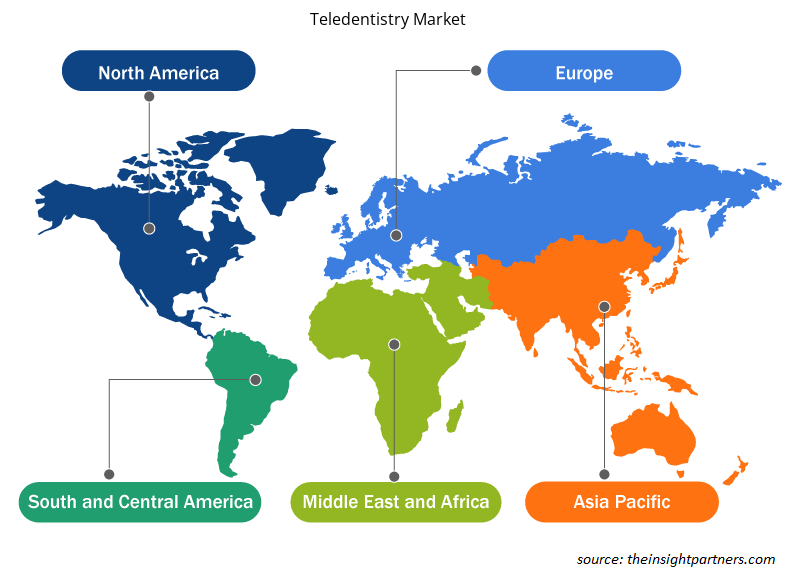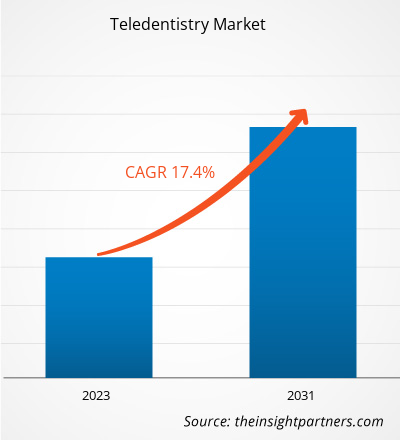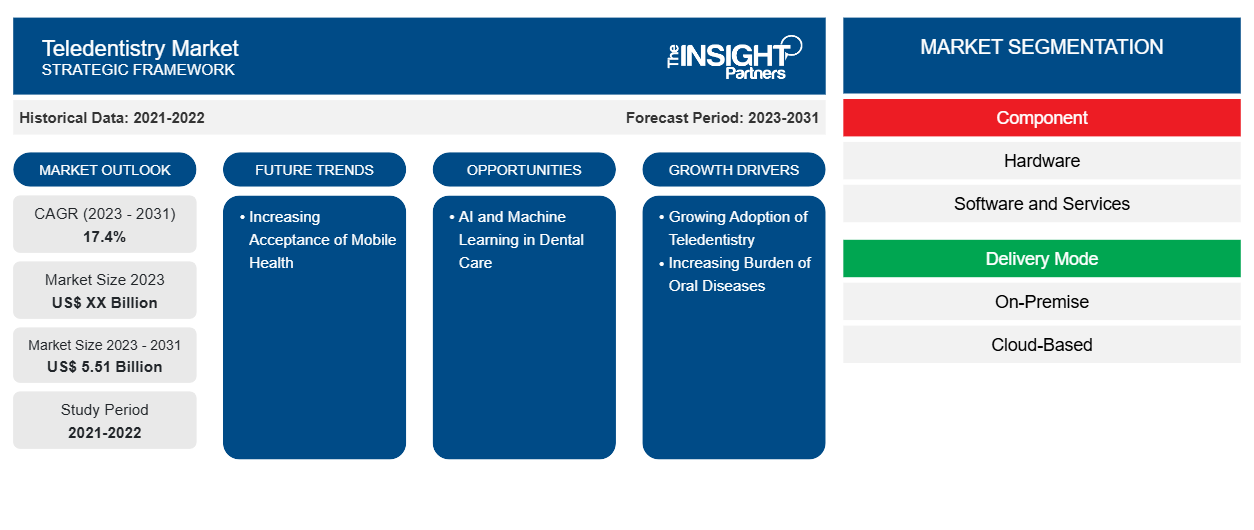Der Markt für Telezahnmedizin belief sich 2021 auf 1,04 Milliarden US-Dollar und soll von XX Milliarden US-Dollar im Jahr 2023 auf 5,51 Milliarden US-Dollar im Jahr 2031 anwachsen. Der Markt dürfte in den Jahren 2023–2031 eine durchschnittliche jährliche Wachstumsrate von 17,4 % verzeichnen. Die zunehmende Akzeptanz der mobilen Gesundheit dürfte weiterhin ein wichtiger Trend auf dem Markt für Telezahnmedizin bleiben.
Marktanalyse für Telezahnmedizin
Das Wachstum des globalen Teledentistry-Marktes ist eine direkte Folge der Vorteile, die er der Zahnmedizinbranche bringt, wie etwa die wachsende Popularität digitaler Gesundheitslösungen, Fortschritte in der Kommunikations- und Bildgebungstechnologie und den Komfort, den er sowohl Zahnärzten als auch Patienten bietet. Wichtige Marktteilnehmer investieren in strategische Aktivitäten wie Übernahmen, Fusionen, Kooperationen und Softwareeinführungen, um ihren Wettbewerbsvorteil zu erhalten, was zu Marktwachstum führt.
Marktübersicht für Telezahnmedizin
Die Telezahnmedizin macht die Zahngesundheitspflege zugänglicher, insbesondere in Entwicklungsländern und in Notfällen. Die Telezahnmedizin ermöglicht durch den Einsatz von Telekommunikationstechnologie den weltweiten Zugang zu Patienten und Zahnärzten, indem regionale Barrieren beseitigt werden. Die wachsende ältere Bevölkerung sowie ihre zunehmende Akzeptanz von Telezahnmedizintechnologien aufgrund ihrer Bequemlichkeit und Kosteneffizienz werden voraussichtlich im Prognosezeitraum das Branchenwachstum vorantreiben. Die COVID-19-Pandemie hat aufgrund der gestiegenen Nachfrage nach virtuellen Gesundheitsdiensten erhebliche positive wirtschaftliche Auswirkungen auf das Telezahnmedizingeschäft gehabt.
Passen Sie diesen Bericht Ihren Anforderungen an
Sie erhalten kostenlos individuelle Anpassungen an jedem Bericht, einschließlich Teilen dieses Berichts oder einer Analyse auf Länderebene, eines Excel-Datenpakets sowie tolle Angebote und Rabatte für Start-ups und Universitäten.
-
Holen Sie sich die wichtigsten Markttrends aus diesem Bericht.Dieses KOSTENLOSE Beispiel umfasst eine Datenanalyse von Markttrends bis hin zu Schätzungen und Prognosen.
Treiber und Chancen auf dem Teledentistry-Markt
Zunehmende Nutzung der Telezahnmedizin fördert Marktwachstum
Telezahnmedizin ist eine relativ neue Praxis für Zahnärzte und zielt darauf ab, Patienten eine breite Palette von Lösungen anzubieten, die sie aus der Ferne erhalten. Angesichts der COVID-19-Pandemie wird erwartet, dass die Nutzung der Telezahnmedizin in den kommenden Jahren stetig zunehmen wird, um die Pandemie zu bewältigen und die Routineversorgung wieder aufzunehmen. Laut einem im November 2020 von DentaQuest Partnership for is a relatively new practice for the dentists and aims to provide patients with a broad range of solutions that are received from a distance. With the COVID-19 pandemic, the use of Oral Care Advancement veröffentlichten Bericht haben etwa 23 % der zahnmedizinischen Dienstleister in den USA begonnen, Patienten über virtuelle Telezahnmedizin-Plattformen zu behandeln. Darüber hinaus deutet die Umfrage auch darauf hin, dass 11 % der Anbieter, die die Technologie derzeit nicht nutzen, planen, sie in naher Zukunft einzusetzen.teledentistry is anticipated to witness a steady increase over the coming years in order to navigate the pandemic as well as to resume routine care. According to a report published by DentaQuest Partnership for teledentistry virtual platforms. Moreover, the survey also suggests that 11% of the providers that are not currently using the technology have plans to use it in the near future.
KI und maschinelles Lernen in der Zahnpflege
Künstliche Intelligenz und maschinelles Lernen sind wesentliche Bestandteile der Telezahnmedizin. Sie bieten personalisierte Behandlungspläne, prädiktive Diagnosen und helfen sogar bei der Behandlungsplanung mit beispielloser Präzision. Virtuelle Konsultationen werden immer fortschrittlicher, mit Echtzeitdiagnosen und interaktiven Sitzungen, die persönlichen Konsultationen und Besuchen ebenbürtig sind.teledentistry. They provide personalized care plans, predictive diagnoses, and even help with treatment planning with unparalleled precision. Virtual consultations are becoming more advanced, with real-time diagnostics and interactive sessions on par with in-person consultations and visits.
Segmentierungsanalyse des Teledentistry-Marktberichts Market Report Segmentation Analysis
Wichtige Segmente, die zur Ableitung der Telezahnmedizin-Marktanalyse beigetragen haben, sind Komponente, Bereitstellungsmodus und Endbenutzer.teledentistry market analysis are component, delivery mode, and end user.
- Basierend auf den Komponenten ist der Teledentistry-Markt in Hardware sowie Software & Services unterteilt. Das Segment Software & Services hatte im Jahr 2023 einen größeren Marktanteil.teledentistry market is bifurcated into hardware, and software & services. The software & services segment held a larger market share in 2023.
- Nach Bereitstellungsmodus ist der Markt in On-Premise und Cloud-basiert unterteilt. Das Cloud-basierte Segment hatte im Jahr 2023 den größeren Marktanteil.
- In Bezug auf den Endnutzer ist der Markt in Patienten, Kostenträger, Anbieter und andere segmentiert. Das Anbietersegment dominierte den Markt im Jahr 2023.
Teledentistry Marktanteilsanalyse nach Geografie Market Share Analysis by Geography
Der geografische Umfang des Teledentistry-Marktberichts ist hauptsächlich in fünf Regionen unterteilt: Nordamerika, Asien-Pazifik, Europa, Naher Osten und Afrika sowie Süd- und Mittelamerika.
Nordamerika dominiert den Markt für Telezahnmedizin. In Nordamerika sind wirtschaftlicher Wohlstand, Bevölkerungswachstum und eine alternde Bevölkerung zusammen mit einer erhöhten Aufmerksamkeit für die Mundgesundheit und einem verbesserten Versicherungsschutz (insbesondere in den USA) die Hauptfaktoren, die zu einem moderaten, aber stetigen Wachstum der gesamten Zahnarztausgaben führen. Telezahnmedizin verbessert die Gesundheit der Amerikaner und spart gleichzeitig Geld, da Pflege und Ausbildung schneller und effizienter erfolgen können.
Regionale Einblicke in den Teledentistry-Markt
Die regionalen Trends und Faktoren, die den Teledentistry-Markt während des Prognosezeitraums beeinflussen, wurden von den Analysten von Insight Partners ausführlich erläutert. In diesem Abschnitt werden auch Teledentistry-Marktsegmente und -Geografie in Nordamerika, Europa, im asiatisch-pazifischen Raum, im Nahen Osten und Afrika sowie in Süd- und Mittelamerika erörtert.

- Holen Sie sich regionale Daten zum Teledentistry-Markt
Umfang des Marktberichts zur Telezahnmedizin
| Berichtsattribut | Details |
|---|---|
| Marktgröße im Jahr 2023 | XX Milliarden US-Dollar |
| Marktgröße bis 2031 | 5,51 Milliarden US-Dollar |
| Globale CAGR (2023 - 2031) | 17,4 % |
| Historische Daten | 2021-2022 |
| Prognosezeitraum | 2023–2031 |
| Abgedeckte Segmente |
Nach Komponente
|
| Abgedeckte Regionen und Länder |
Nordamerika
|
| Marktführer und wichtige Unternehmensprofile |
|
Dichte der Marktteilnehmer im Bereich Teledentistry: Die Auswirkungen auf die Geschäftsdynamik verstehen
Der Markt für Teledentistry wächst rasant, angetrieben durch die steigende Nachfrage der Endnutzer aufgrund von Faktoren wie sich entwickelnden Verbraucherpräferenzen, technologischen Fortschritten und einem größeren Bewusstsein für die Vorteile des Produkts. Mit steigender Nachfrage erweitern Unternehmen ihr Angebot, entwickeln Innovationen, um die Bedürfnisse der Verbraucher zu erfüllen, und nutzen neue Trends, was das Marktwachstum weiter ankurbelt.
Die Marktteilnehmerdichte bezieht sich auf die Verteilung von Firmen oder Unternehmen, die in einem bestimmten Markt oder einer bestimmten Branche tätig sind. Sie gibt an, wie viele Wettbewerber (Marktteilnehmer) in einem bestimmten Marktraum im Verhältnis zu seiner Größe oder seinem gesamten Marktwert präsent sind.
Die wichtigsten auf dem Teledentistry-Markt tätigen Unternehmen sind:
- ViDe Virtual Dental,
- Koninklijke Philips NV,
- Die TeleZahnärzte,
- MouthWatch LLC,
- Denteractive Solutions, Inc.,
- Patterson Companies, Inc.,
Haftungsausschluss : Die oben aufgeführten Unternehmen sind nicht in einer bestimmten Reihenfolge aufgeführt.

- Überblick über die wichtigsten Akteure auf dem Teledentistry-Markt
Neuigkeiten und aktuelle Entwicklungen zum Teledentistry-Markt
Der Markt für Telezahnmedizin wird durch die Erhebung qualitativer und quantitativer Daten nach Primär- und Sekundärforschung bewertet, die wichtige Unternehmenspublikationen, Verbandsdaten und Datenbanken umfasst. Im Folgenden finden Sie eine Liste der Entwicklungen auf dem Markt für Telezahnmedizin:
- The TeleDentists kündigt unsere neue und verbesserte Plattform an, die von AmWell betrieben wird. Patienten können nun über die AmWell Telehealth-Plattform auf TeleDental-Dienste zugreifen. Die Dienste von TeleDentists sind landesweit rund um die Uhr an 365 Tagen im Jahr verfügbar. (Quelle: The TeleDentists, Pressemitteilung, 2023)
- Virtual Dental Care (VDC), die Entwickler von Teledentix, und Cigna haben sich zusammengetan, um den Zugang zu zahnärztlicher On-Demand-Versorgung, einschließlich Notfallversorgung, zu verbessern. Über die sichere Teledentix-Software von VDC können Cigna-Kunden per Video, Text, Chat und E-Mail mit einem Zahnarzt Kontakt aufnehmen, um sofortige Unterstützung zu erhalten. (Quelle: Teledentix, Pressemitteilung, 2022)
- Dentulu ist eine Partnerschaft mit Pearl eingegangen, dem Gewinner der „Best of Class“-KI-Technologie 2022, um es den Telezahnärzten von Dentulu zu ermöglichen, die höchste diagnostische Leistung zu erreichen und gleichzeitig das Patientenerlebnis zu verbessern. (Quelle: Dentulu, Inc., Pressemitteilung, 2023)
Umfang und Ergebnisse des Teledentistry-Marktberichts
Der Bericht „Marktgröße und Prognose für Teledentistry (2021–2031)“ bietet eine detaillierte Analyse des Marktes, die die folgenden Bereiche abdeckt:
- Marktgröße und Prognose auf globaler, regionaler und Länderebene für alle wichtigen Marktsegmente, die im Rahmen des Projekts abgedeckt sind
- Marktdynamik wie Treiber, Beschränkungen und wichtige Chancen
- Wichtige Zukunftstrends
- Detaillierte PEST/Porters Five Forces- und SWOT-Analyse
- Globale und regionale Marktanalyse mit wichtigen Markttrends, wichtigen Akteuren, Vorschriften und aktuellen Marktentwicklungen
- Branchenlandschaft und Wettbewerbsanalyse, einschließlich Marktkonzentration, Heatmap-Analyse, prominenten Akteuren und aktuellen Entwicklungen
- Detaillierte Firmenprofile
- Historische Analyse (2 Jahre), Basisjahr, Prognose (7 Jahre) mit CAGR
- PEST- und SWOT-Analyse
- Marktgröße Wert/Volumen – Global, Regional, Land
- Branchen- und Wettbewerbslandschaft
- Excel-Datensatz
Aktuelle Berichte
Erfahrungsberichte
Grund zum Kauf
- Fundierte Entscheidungsfindung
- Marktdynamik verstehen
- Wettbewerbsanalyse
- Kundeneinblicke
- Marktprognosen
- Risikominimierung
- Strategische Planung
- Investitionsbegründung
- Identifizierung neuer Märkte
- Verbesserung von Marketingstrategien
- Steigerung der Betriebseffizienz
- Anpassung an regulatorische Trends























 Kostenlose Probe anfordern für - Markt für Telezahnmedizin
Kostenlose Probe anfordern für - Markt für Telezahnmedizin